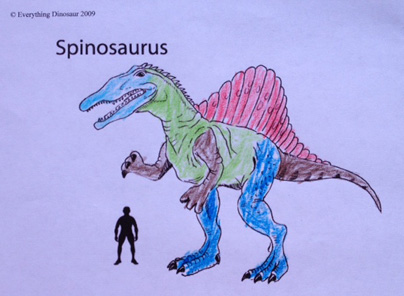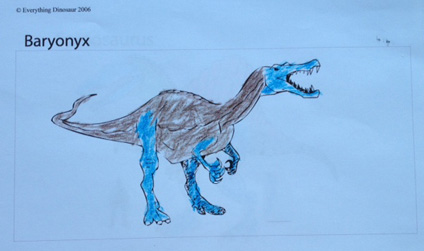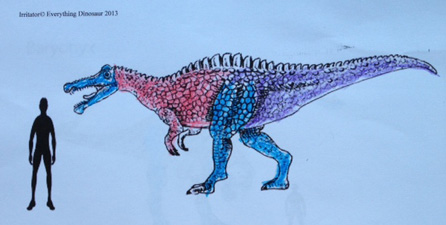Stephen’s Spinosauridae – A Colourful Collection
During a recent visit to The Beacon museum (Whitehaven, Cumbria), we met a budding young palaeontologist called Stephen and his dad. Having discovered that amongst all the dinosaurs that Stephen knew about, the spinosaurs were some of his favourites, we promised, that on return to our offices, we would send out some pictures of various members of the spinosaur family for Stephen to colour in.
The Spinosauridae
The Spinosauridae are a family of specialised, large to gigantic theropod (Tetanuran) dinosaurs. Originating perhaps as early as the Middle Jurassic, fossils of spinosaurs are known from Cretaceous-aged strata from South America, Africa, Europe, south-east Asia and possibly Australia.
Stephen’s Spinosaurus (S. aegyptiacus)
Picture credit: Stephen/Everything Dinosaur
Stephen has produced a very striking and colourful dinosaur drawing. That huge sail running down the back of this dinosaur has been coloured bright red, perhaps in recognition that some palaeontologists think that the sail may have been used for visual communication between these large, bipeds.
Colouring the Spinosaurids
Although, most spinosaurs are known from only fragmentary material, the bauplan (body plan), of this dinosaur family seems to have been broadly similar. The skulls were elongated with narrow snouts. The jaws were superficially similar to extant crocodiles, with their kinked upper jaws and their very many conical teeth (Spinosaurus aegyptiacus may have had over two hundred teeth in its jaws). The teeth lacked denticles (serrations) or had very small denticles. The forelimbs of those specimens in which arm material has been ascribed, were very well developed. Most spinosaurs probably had three digits, the thumb being the largest and ending in a huge and highly curved claw.
Theropod Dinosaur
Size estimates for these dinosaurs vary widely. It has been estimated for example, that S. aegyptiacus may have reached lengths in excess of seventeen metres and it may have weighed in excess of ten tonnes, making it far larger than any known tyrannosaur or abelisaurid. Such an animal could be heralded as the largest land carnivore known to science.
Britain’s very own spinosaurid (Baryonyx walkeri) could have reached lengths in excess of ten metres. Scientists are not actually sure how big Baryonyx was, as the specimen excavated from the Surrey clay pit which forms the holotype was not fully grown. Remains of a similar animal called Suchomimus (crocodile mimic) have been unearthed in North Africa, this animal was over eleven metres long and some palaeontologists believe that it is actually a large Baryonyx.
Baryonyx by Stephen (B. walkeri)
Picture credit: Stephen/Everything Dinosaur
Carnivorous Dinosaurs
These animals were most definitely carnivores, but whether or not they were specialised fish-eaters remains open to debate. Certainly, there is some evidence that these dinosaurs were piscivores. However, as well as there being evidence for habitually feeding on fish, spinosaurid teeth have been found embedded in pterosaur fossil bone and the Surrey Baryonyx specimen is associated with the partially digested remains of a young iguanodont which was found where the stomach would have been located.
A South American Spinosaur Illustrated
Picture credit: Stephen/Everything Dinosaur
Recently, some new Spinosauridae/Baryonchidae fossils have been found on the Isle of Wight. Everything Dinosaur team members have been able to view some of this material, including elements of the premaxilla and teeth. There are a couple of things we can say with a degree of certainty. There are probably a number of members of the Spinosauridae still awaiting discovery and that their colouration is unknown.
We challenged young Stephen, who had demonstrated his knowledge of dinosaurs, to illustrate some members of this particular theropod dinosaur family using some drawing materials that we emailed over.
Stephen Gets to Grips with Ichthyovenator (I. laosensis)
Picture credit: Stephen/Everything Dinosaur
Ichthyovenator
Ichthyovenator is known from fragmentary remains that were discovered in Laos in 2010. Fossil bones include vertebrae, a partial rib, plus elements of the hip area. All the fossil material represents post cranial material, no skull fossils were found. The striking thing about this basal spinosaurid, currently assigned to the Baryonchidae is that it may have had two sails, running down its spine. One sail seems to conclude at the first sacral vertebrae (back bones above the hip), the second starting from the second sacral vertebrae.
I. laosensis was formally named and described a year ago. Stephen has opted to give his Ichthyovenator a bright red body but with a blue skull and blue hind legs.
The Beacon Museum
We were very pleased to meet Stephen and all the other fans of prehistoric animals that visited the wonderful Beacon museum to view their Ice Age exhibition and to marvel at all the amazing shark exhibits that were on display. Thanks for the illustrations, much appreciated.
To view various spinosaurid models and replicas incluiding Spinosaurus and Baryonyx figures take a look at the models and figures section on Everything Dinosaur’s website: Everything Dinosaur Prehistoric Animal Models and Figures.










Leave A Comment